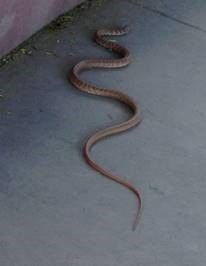The Red Racer

WHAT WETLANDS PARK RESIDENT HOLDS THE RECORD FOR FASTEST SNAKE IN NORTH AMERICA?
This is the view we most often get of a red racer snake (Coluber flagellum piceus) at Clark County Wetlands Park: from its tail as the snake hurries away! These slender, diurnal hunters are among the longest snakes in the Mojave Desert, growing five or more feet long by adulthood.
Traveling at up to seven miles an hour, these fast-moving snakes are most active during the hot summer months. This makes sense as the lizards they favor for food are active then. Racers round out their diet with other snakes, birds, small mammals, and insects. They subdue their prey without the aid of venom or constriction. Instead, they crush their victims with their strong jaws or pin them down under their powerful bodies.
Red racers are also called “coachwhips” because their length and coloration make them resemble a braided whip, with faded, broken dark bands on a reddish-pink background near the head, and more solid color down the body to the tail.
I particularly love their large, fierce, amber-colored eyes. They are easy to see when the snake “periscopes,” like the one I met once along the paved trail near Vern’s Pond. He raised the forward part of his body and swayed from side to side as I approached, staring at me the whole time. When I got a little too close for his comfort, he advanced aggressively, and “stood up” again to make me back off. When I did, he was off like a shot, disappearing into the rocks beside the trail.
A snake so lovely to look at… but hands off, please! Herpetologist Robert Stebbins has described racers as defending themselves “with spirit” when approached, hissing and striking repeatedly. When caught, they usually bite, and bite hard! I can vouch from personal experience that being bitten by a large racer is painful, and the bite can break the skin.
If you see a red racer out and about, stop and enjoy from a distance. Too often, all we have time to see is it slinking off from the rear!
Please enjoy these YouTube videos!
Nature Minute Episode Five: Burrow Raiding – YouTube
– By Chris Leavitt, President; photo by Gail Raffel
